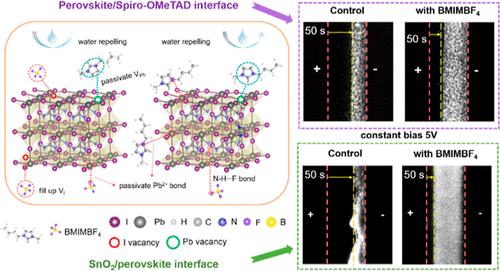当前位置:
X-MOL 学术
›
ACS Sustain. Chem. Eng.
›
论文详情
Our official English website, www.x-mol.net, welcomes your
feedback! (Note: you will need to create a separate account there.)
Direct Observation of Suppressing Ion Migration at Surface and Buried Interface toward Stable Perovskite Solar Cells
ACS Sustainable Chemistry & Engineering ( IF 7.1 ) Pub Date : 2024-11-08 , DOI: 10.1021/acssuschemeng.4c07322 Zhongli Guo, Jinjian Yan, Shanshan Zhao, Jing Zhang, Lihua Lu, Yikai Yun, Beier Hu, Hongqiang Luo, Mengyu Chen, Kai Huang, Cheng Li, Rong Zhang
ACS Sustainable Chemistry & Engineering ( IF 7.1 ) Pub Date : 2024-11-08 , DOI: 10.1021/acssuschemeng.4c07322 Zhongli Guo, Jinjian Yan, Shanshan Zhao, Jing Zhang, Lihua Lu, Yikai Yun, Beier Hu, Hongqiang Luo, Mengyu Chen, Kai Huang, Cheng Li, Rong Zhang

|
Ion migration can lead to detrimental consequences, including hysteresis effects, interfacial reactions, etc., which degrades the stability and efficiency of perovskite solar cells (PSCs). Ionic liquid has been introduced to enhance the stability of PSCs, yet the detailed mechanism is still under debate. To address the question, in situ wide-field photoluminescence microscopy is employed to characterize the ion migration, which is found more obviously suppressed at the perovskite buried interface than the surface after 1-butyl-3-methylimidazolium tetrafluoroborate (BMIMBF4) modification. The experimental results show that BF4– is distributed mainly at the buried interface, while BMIM exists throughout the perovskite film and accumulates at the surface. BF4– can suppress ion migration through filling the iodine vacancies and passivating undercoordinated Pb2+, thus reducing the defect density. Meanwhile, BMIM+ can passivate lead vacancies (VPb) and undercoordinated Pb2+ across the whole perovskite film, effectively decreasing the Pb-related defects. Consequently, PSCs incorporated with BMIMBF4 exhibit enhanced power conversion efficiency and stability. This study provides a comprehensive understanding of the role of ionic liquids in the ion migration of perovskite interfaces and its impact on the performance of PSCs.
中文翻译:

直接观察抑制表面和埋藏界面离子迁移向稳定的钙钛矿太阳能电池
离子迁移会导致有害后果,包括磁滞效应、界面反应等,从而降低钙钛矿太阳能电池 (PSC) 的稳定性和效率。离子液体已被引入以增强 PSC 的稳定性,但其详细机制仍在争论中。为了解决这个问题,采用原位宽视场光致发光显微镜来表征离子迁移,发现在 1-丁基-3-甲基咪唑鎓四氟硼酸盐 (BMIMBF4) 修饰后,钙钛矿埋藏界面比表面更明显地抑制离子迁移。实验结果表明,BF4– 主要分布在埋地界面,而 BMIM 存在于整个钙钛矿薄膜中并积累在表面。BF4– 可以通过填充碘空位和钝化配位不足的 Pb2+ 来抑制离子迁移,从而降低缺陷密度。同时,BMIM+ 可以钝化整个钙钛矿薄膜中的铅空位 (VPb) 和配位不足的 Pb2+,有效减少 Pb 相关缺陷。因此,与 BMIMBF4 掺入的 PSC 表现出增强的功率转换效率和稳定性。本研究全面了解离子液体在钙钛矿界面离子迁移中的作用及其对 PSC 性能的影响。
更新日期:2024-11-08
中文翻译:

直接观察抑制表面和埋藏界面离子迁移向稳定的钙钛矿太阳能电池
离子迁移会导致有害后果,包括磁滞效应、界面反应等,从而降低钙钛矿太阳能电池 (PSC) 的稳定性和效率。离子液体已被引入以增强 PSC 的稳定性,但其详细机制仍在争论中。为了解决这个问题,采用原位宽视场光致发光显微镜来表征离子迁移,发现在 1-丁基-3-甲基咪唑鎓四氟硼酸盐 (BMIMBF4) 修饰后,钙钛矿埋藏界面比表面更明显地抑制离子迁移。实验结果表明,BF4– 主要分布在埋地界面,而 BMIM 存在于整个钙钛矿薄膜中并积累在表面。BF4– 可以通过填充碘空位和钝化配位不足的 Pb2+ 来抑制离子迁移,从而降低缺陷密度。同时,BMIM+ 可以钝化整个钙钛矿薄膜中的铅空位 (VPb) 和配位不足的 Pb2+,有效减少 Pb 相关缺陷。因此,与 BMIMBF4 掺入的 PSC 表现出增强的功率转换效率和稳定性。本研究全面了解离子液体在钙钛矿界面离子迁移中的作用及其对 PSC 性能的影响。


















































 京公网安备 11010802027423号
京公网安备 11010802027423号